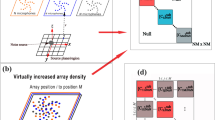Abstract
An approach combining optimal antenna subset selection with blind detection scheme for Orthogonal Space-Time Block Coding (OSTBC) is proposed in this paper. The optimal antenna subset selection is taken into account at transmitter and/or receiver sides, which chooses the optimal antennas to increase the diversity order of OSTBC and improve further its performance. In order to enhance the robustness of the detection used in the conventional OSTBC scheme, a blind detection scheme based on Independent Component Analysis (ICA) is exploited which can directly extract transmitted signals without channel estimation. Performance analysis shows that the proposed approach can achieve the full diversity and the flexibility of system design by using the antenna selection and the ICA based blind detection schemes.
Similar content being viewed by others
References
M. Z. Win, J. H. Winters. Analysis of hybrid selection/maximal-ratio combining in Rayleigh fading. IEEE Transactions on Communications, 47(1999)12, 1773–1776.
F. Molisch, M. Z. Win, J. H. Winters. Reduced-complexity transmit/receive-diversity systems. IEEE Transactions on Communications, 51(2001)11, 1996–2000.
S. M. Alamouti. A simple transmit diversity technique for wireless communications. IEEE Journal on Selected Areas in Communications, 16(1998)8, 1451–1458.
V. Tarokh, H. Jafarkhani, A. R. Calderbank. Space-time block codes from orthogonal designs. IEEE Transactions on Information Theory, 45(1999)5, 1456–1467.
Z. Chen, J. Yuan, B. Vucetic, et al. Performance of Alamouti scheme with transmit antenna selection. Electronics Letters, 39(2003)23, 1666–1668.
A. Hyvarinen, E. Oja. A fast fixed-point algorithm for independent component analysis. Neural Computation, 9(1997)7, 1483–1492.
J. F. Cardoso, B. H. Laheld. Equivariant adaptive source separation. IEEE Transactions on Signal Processing, 44(1996)12, 3017–3030.
J. F. Cardoso, A. Souloumiac. Blind beamforming for non Gaussian signals. IEE Proceedings-F, 140(1993)6, 362–370.
J. Joutsensalo, T. Ristaniemi. Learning algorithms for blind multiuser detection in CDMA downlink. in Proc. 9th IEEE International Symposium on Personal, Indoor, and Mobile Radio Communications (PIMRC’98), Boston, U.S.A, Sept. 1998, 1040–1044.
T. Ristaniemi, J. Joutsensalo. On the performance of blind source separation in CDMA downlink. in Proc. International Workshop on Independent Component Analysis and Signal Separation (ICA’99), Aussois, France, Jan. 1999, 437–441.
T. Ristaniemi, K. Raju, J. Karhunen, et al. ICA-assisted inter-cell-interference cancellation in CDMA array systems. in Proc. 4th International Symposium on Independent Component Analysis and Blind Signal Separation (ICA’03), Nara, Japan, Apr. 2003, 739–744.
J. Liu, A. P. Iserte, M. A. Lagunas. Blind separation of OSTBC signals using ICA neural networks. in Proc. IEEE International Symposium on Signal Processing and Information Technology (ISSPIT’03), Darmstadt, Germany, Dec. 2003, 502–505.
Author information
Authors and Affiliations
Corresponding author
Additional information
Partially supported by National Natural Science Foundation of China (60572105), Open Foundations of the State Key Laboratory of Mobile Communications (A200508), the State Key Lab of Integrated Services Networks (ISN7-02), and the Program for New Century Excellent Talents (NCET-05-0582) in University.
About this article
Cite this article
Xu, H., Liu, J. & Gu, B. Optimal antenna subset selection and blind detection approach applied to orthogonal space-time block coding. J. of Electron.(China) 24, 150–156 (2007). https://doi.org/10.1007/s11767-005-0101-2
Received:
Revised:
Published:
Issue Date:
DOI: https://doi.org/10.1007/s11767-005-0101-2
Key words
- Orthogonal Space-Time Block Coding (OSTBC)
- Antenna subset selection
- Independent Component Analysis (ICA)
- Channel State Information (CSI)




